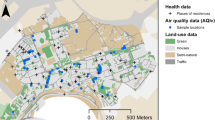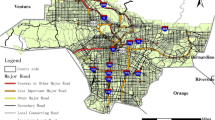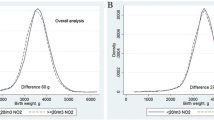Abstract
Several environmental health studies suggest birth weight is associated with outdoor air pollution during gestation. In these studies, exposure assignments are usually based on measurements collected at air quality monitoring stations that do not coincide with health data locations. So, estimated exposures can be misleading if they do not take into account the uncertainty of exposure estimates. In this article we conducted a semi-ecological study to analyze associations between air quality during gestation and birth weight. Air quality during gestation was measured using a biomonitor, as an alternative to traditional air quality monitoring stations data, in order to increase spatial resolution of exposure measurements. To our knowledge this is the first time that the association between air quality and birth weight is studied using biomonitors. To address exposure uncertainty at health locations, we applied geostatistical simulation on biomonitoring data that provided multiple equally probable realizations of biomonitoring data, with reproduction of observed histogram and spatial covariance while matching for conditioning data. Each simulation represented a measure of exposure at each location. The set of simulations provided a measure of exposure uncertainty at each location. To incorporate uncertainty in our analysis we used generalized linear models, fitted simulation outputs and health data on birth weights and assessed statistical significance of exposure parameter using non-parametric bootstrap techniques. We found a positive association between air quality and birth weight. However, this association was not statistically significant. We also found a modest but significant association between air quality and birth weight among babies exposed to gestational tobacco smoke.







Similar content being viewed by others
References
Asta J, Erhardt W, Ferretti M, Fornasier F (2002) In: Nimis PL, Scheidegger C, Wolseley PA (eds) Monitoring with lichens—monitoring lichens, vol 7. Springer Netherlands, Dordrecht, pp 273–279. doi:10.1007/978-94-010-0423-7
Augusto S, Pinho P, Branquinho C, Pereira MJ, Soares A, Catarino F (2004) Atmospheric dioxin and furan deposition in relation to land-use and other pollutants: a survey with lichens. J Atmos Chem 49:53–65
Augusto S, Pereira MJ, Soares A, Branquinho C (2007) The contribution of environmental biomonitoring with lichens to assess human exposure to dioxins. Int J Hyg Environ Health 210:433–438
Augusto S, Máguas C, Matos J, Pereira MJ, Soares A, Branquinho C (2009) Spatial modeling of PAHs in lichens for fingerprinting of multisource atmospheric pollution. Environ Sci Technol 43:7762–7769
Baeten JM, Bukusi EA, Lambe M (2001) Pregnancy complications and outcomes among overweight and obese nulliparous women. Am J Public Health 91:436–440
Bell ML, Ebisu K, Belanger K (2007) Ambient air pollution and low birth weight in Connecticut and Massachusetts. Environ Health Perspect 115(7):1118–1124
Bobak M (2000) Outdoor air pollution, low birth weight, and prematurity. Environ Health Perspect 108:173–176
Branquinho C (2001) Lichens. In: Prasad MNV (ed) Metals in the environment-analysis by biodiversity. Marcel Dekker, New York, p 487
Centre for Natural Resources and the Environment (2000) GeoMS
Cislaghi C, Nimis PL (1997) Lichens, air pollution and lung cancer. Nature 387:463–464
Cnattingius S, Bergström R, Lipworth L, Kramer MS (1998) Prepregnancy weight and the risk of adverse pregnancy outcomes. New Engl J Med 338:147–152
Darrow L, Klein M, Strickland MJ, Mulholland JA, Tolbert PE (2011) Ambient air pollution and birth weight in full-term infants in Atlanta, 1994–2004. Environ Health Perspect 119:731–737
Dejmek J, Selevan SG, Benes I, Solanský I, Srám RJ (1999) Fetal growth and maternal exposure to particulate matter during pregnancy. Environ Health Perspect 107:475–480
Efron B (1988) Bootstrap confidence intervals: good or bad? Psychol Bull 104(2):293–296
Environmental Systems Research Institute (2006) ArcGIS. ESRI Inc
Fenton TR (2003) A new growth chart for preterm babies: Babson and Benda’ s chart updated with recent data and a new format. BMC Pediatr 10:1–10
Fenton TR, Sauve RS (2007) Using the LMS method to calculate z-scores for the Fenton preterm infant growth chart. Eur J Clin Nutr 61:1380–1385
Fraser AM, Brockert JE, Ward RH (1995) Association of young maternal age with adverse reproductive outcomes. New Eng J Med 332:1113–1117
Garty J (2001) Biomonitoring atmospheric heavy metals with lichens: theory and application. Crit Rev Plant Sci 20:309–371
Gerharz LE, Pebesma E (2013) Using geostatistical simulation to disaggregate air quality model results for individual exposure estimation on GPS tracks. Stoch Env Res Risk Assess 27:223–234
Glinianaia SV, Rankin J, Bell R, Pless-Mulloli T, Howel D (2004) Particulate air pollution and fetal health: a systematic review of the epidemiologic evidence. Epidemiology (Cambridge Mass.) 15:36–45
Goovaerts P (1997) Geostatistics for natural resources evaluation. Oxford University Press, New York
Grypari A, Paciorek CJ, Zeka A, Schwartz J, Coull BA (2009) Measurement error caused by spatial misalignment in environmental epidemiology. Biostatistics 10:258–274
IOM (Institute Of Medicine), NRC (National Research Council) (2009) In: Rasmussen KM, Yaktine AL (eds) Weight gain during pregnancy: reexamining the guidelines. Washington, DC: The National Academies Press
Kabiru W, Raynor BD (2004) Obstetric outcomes associated with increase in BMI category during pregnancy. Am J Obstet Gynecol 191:928–932
Kramer MS (1987) Determinants of low birth weight: methodological assessment and meta-analysis. Bull World Health Organ 65:663–737
Kramer MS (2003) The epidemiology of adverse pregnancy outcomes: an overview. J Nutr 133:1592S–1596S
Kramer MS, Olivier M, McLean F (1990) Determinants of fetal growth and body proportionality. Pediatrics 86:18–26
Kristensen P, Irgens LM, Andersen A, Bye AS, Sundheim L (1997) Gestational age, birth weight, and perinatal death among births to Norwegian farmers, 1967–1991. Am J Epidemiol 146:329–338
Kuczmarski RJ, Ogden CL, Guo SS, Grummer-Strawn LM, Flegal KM, Mei Z, Wei R, Curtin LR, Roche AF, Johnson CL (2002) 2000 CDC Growth Charts for the United States: methods and development. Vital and health statistics. Series 11, Data from the National Health Survey
Kunzli N, Tage IB (1997) The semi-individual study in air pollution epidemiology: a valid design compared to ecologic studies. Environ Health Perspect 105:1078–1083
Llop E, Pinho P, Matos P, Pereira MJ, Branquinho C (2012) The use of lichen functional groups as indicators of air quality in a Mediterranean urban environment. Ecol Ind 13:215–221
Loppi S, Pirintsos S (2000) Effect of dust on epiphytic lichen vegetation in the mediterranean area (Italy and Greece). Israel J Plant Sci 48:91–95
Maisonet M, Bush T, Correa A (2001) Relation between ambient air pollution and low birth weight in the Northeastern United States. Environ Health Perspect 109(Suppl):351–356
Maisonet M, Correa A, Misra D, Jaakkola JJK (2004) A review of the literature on the effects of ambient air pollution on fetal growth. Environ Res 95:106–115
Martin MH, Coughtrey PJ (1982) Biological monitoring of heavy metal pollution: land and air. Applied Science Publishers, New York
Moreira P, Padez C, Mourão-Carvalhal I, Rosado V (2007) Maternal weight gain during pregnancy and overweight in Portuguese children. Int J Obes 31:608–614
Nelder JA, Wedderburn RW (1972) Generalized linear models. R Stat Soc 135:370–384
Pannatier Y (1996) Variowin: software for spatial data analysis in 2D. Springer, New York
Pannatier Y (1998) Variowin 2.21
Parker JD, Woodruff TJ, Basu R, Schoendorf KC (2005) Air pollution and birth weight among term infants in California. Pediatrics 115:121–128
Perera FP (2008) Children are likely to suffer most from our fossil fuel addiction. Environ Health Perspect 116:987–990
Pinho P, Augusto S, Máguas C, Pereira MJ, Soares A, Branquinho C (2008) Impact of neighbourhood land-cover in epiphytic lichen diversity: analysis of multiple factors working at different spatial scales. Environ Pollut (Barking, Essex: 1987) 151:414–422
Ribeiro MC, Pereira MJ, Soares A, Branquinho C, Augusto S, Llop E, Fonseca S, Nave JG, Tavares AB, Dias CM, Silva A, Selemane I, de Toro J, Santos MJ, Santos F (2010) A study protocol to evaluate the relationship between outdoor air pollution and pregnancy outcomes. BMC Public Health 10:613
Ritz B, Wilhelm M, Hoggatt KJ, Ghosh JKC (2007) Ambient air pollution and preterm birth in the environment and pregnancy outcomes study at the University of California, Los Angeles. Am J Epidemiol 166:1045–1052
Rogers JF, Dunlop AL (2006) Air pollution and very low birth weight infants: a target population? Pediatrics 118:156–164
Schieve L, Cogswell M (2000) Prepregnancy body mass index and pregnancy weight gain: associations with preterm delivery. Obstet Gynecol 96:194–200
Shah PS (2010) Parity and low birth weight and preterm birth: a systematic review and meta-analyses. Acta Obstet Gynecol Scand 89:862–875
Soares A (2001) Direct sequential simulation and cosimulation. Math Geol 33:911–926
Spiegelman D (2010) Approaches to uncertainty in exposure assessment in environmental epidemiology. Annu Rev Public Health 31:149–163
Spss Inc (2010) IBM SPSS statistics base 19. Statistics
Šrám RJ, Binková B, Dejmek J, Bobak M (2005) Ambient air pollution and pregnancy outcomes: a review of the literature. Environ Health Perspect 113:375–382
Thurston SW, Spiegelman D, Ruppert D (2003) Equivalence of regression calibration methods in main study/external validation study designs. J Stat Plan Inference 113:527–539
Waller LA, Gotway CA (2004) Applied spatial statistics for public health data, environmental health. Wiley, New York
Wang X, Ding H, Ryan L, Xu X (1997) Association between air pollution and low birth weight: a community-based study. Environ Health Perspect 105:514–520
WHO European Centre for Environment and Health (2005) The effects of air pollution on children’s health and development: a review of the evidence. World Health Bonn, Switzerland
Young LJ, Gotway CA (2007) Linking spatial data from different sources: the effects of change of support. Stoch Environ Res Risk Assess 21:589–600
Acknowledgments
The work was done under the research project GISA, funded by private companies: GALP, Repsol, APS, AdSA, AICEP, CARBOGAL, EDP, EuroResinas, KIMAXTRA, REN and GENERG; and managed by local authorities: CCDRA, ARSA and Municipalities of Sines, Santiago do Cacém, Grândola, Álcacer do Sal and Odemira. The authors also acknowledge all mothers participating in the project for their contributions and FCT-MEC for financial support (SFRH/BD/86599/2012, SFRH/BPD/75425/2010, PTDC/AAC-CLI/104913/2008). The authors declare no competing financial interests.
Author information
Authors and Affiliations
Corresponding author
Rights and permissions
About this article
Cite this article
Castro Ribeiro, M., Pinho, P., Llop, E. et al. Associations between outdoor air quality and birth weight: a geostatistical sequential simulation approach in Coastal Alentejo, Portugal. Stoch Environ Res Risk Assess 28, 527–540 (2014). https://doi.org/10.1007/s00477-013-0770-6
Published:
Issue Date:
DOI: https://doi.org/10.1007/s00477-013-0770-6




